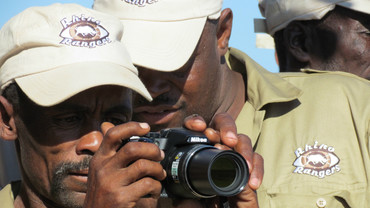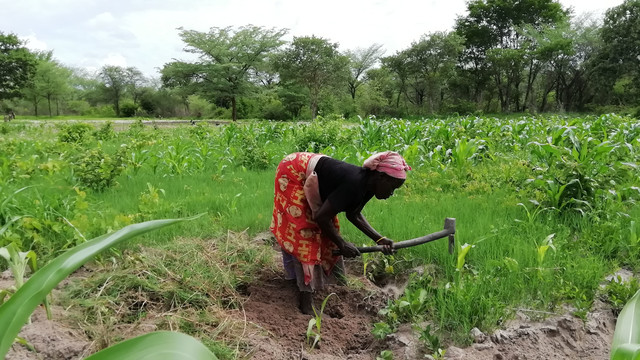Q&A: Strengthening community voices to tackle illegal wildlife trade in Tanzania and Zambia
How can local communities be more effectively engaged in efforts to tackle wildlife crime? We spoke with Zakaria Faustin and Rodgers Lubilo about what they have learned about tackling wildlife crime at the community level and how they are taking this work forward.

 Since 2018 IIED has worked with the Tanzania Natural Resources Forum (TNRF) and Zambia Community-Based Natural Resource Management Forum (Zambia CBNRM Forum) to better support community involvement in efforts to tackle wildlife poaching.
Since 2018 IIED has worked with the Tanzania Natural Resources Forum (TNRF) and Zambia Community-Based Natural Resource Management Forum (Zambia CBNRM Forum) to better support community involvement in efforts to tackle wildlife poaching.
TNRF and Zambia CBNRM Forum are partners on the IIED-led 'LeAP: Learning and Action Platform for Community Engagement Against IWT' project, funded by the UK government’s Illegal Wildlife Trade (IWT) Challenge Fund. Their activities have focused on strengthening local voices in decision-making in Tanzania and Zambia by convening national dialogues that brought communities together with government policymakers, as well as with anti-IWT project funders and implementers.
Both organisations have also been listening to local people living near poaching hotspots, as well as policymakers, to explore how to better support community-based efforts to tackle wildlife crime.
Here, we talk to Zakaria Faustin (ZF), executive director at TNRF, and Rodgers Lubilo (RL), board chairperson at Zambia CBNRM Forum, about why communities need to be engaged in anti-poaching approaches, what more needs to be done in Tanzania and Zambia, and why both organisations have been developing a national framework on this issue.
Q: Why is it important to prioritise local community leadership and engagement in response to the illegal wildlife trade?
ZF: Local communities living alongside wildlife can be the first line of defence against poaching – acting as the ‘eyes and ears’ against wildlife crime. Community leaders are very effective at stopping poaching among their peers by raising awareness of both the importance of wildlife conservation and the penalties associated with engaging in IWT. These leaders are often well aware of who is engaged in poaching (both inside and outside the community) and the illegal trade of wildlife, so it’s important to involve them in conservation efforts.
RL: Community engagement is very important because it is the communities who are going to influence behaviour – they are the people with the information on poaching activities and who should be part of the first line of defence. These people live alongside wildlife, so without their support poaching is unlikely to reduce.
Q: What evidence is there that local community leadership and engagement is helping to combat IWT in Tanzania and Zambia?
ZF: There are several successful examples of this in Tanzania. For example, within Wildlife Management Areas (WMAs) community members are selected to be village game scouts to patrol and report on illegal activities. In 2020 we supported 160 scouts in several of these areas with training, resources and equipment to help them to be more effective – at gathering data and reporting on wildlife and incidents of poaching.
These scouts are well respected within their communities and have improved protection of wildlife within the WMAs – in return we pay them allowances to cover basic logistics costs.
RL: We also have some great examples in Zambia. We have community resource boards that provide community members with leadership positions at the local level. Community wildlife scouts are employed through these boards, and have proved to be very effective at patrolling and investigating illegal activities to combat illegal poaching. Board members have also been involved in conducting meetings to raise awareness of issues surrounding poaching and IWT.

Women and men meet to discuss illegal wildlife trade in Zambia (Photo: copyright Zambia CBNRM Forum)
Q: What lessons can be drawn from experiences in your countries about local community leadership and engagement in tackling IWT?
ZF: First and foremost, local communities must be incentivised to protect wildlife – we’ve found that economic benefits are the most effective. But it's also important to look at why local people are engaging in these practices in the first place. For example, we’ve seen an increasing need to look at how climate change and human-wildlife conflict are impacting motivations to engage in poaching.
For example, more and more people are having to compete with wildlife for water due to drought – but sharing these spaces can lead to higher risk of conflict. Some communities who were originally smallholder farmers might think that it’s easier to poach instead of their traditional farming methods. We need to be more strategic and address these as interlinked, not separate, issues.
This has started happening, for example by drilling bore holes so that people, but not wildlife, can access water. But overall more needs to be done to implement solutions that are addressing the right issues.
RL: We’ve learnt that tackling IWT needs to go beyond just patrolling wildlife areas or arresting poachers – we need to better understand the dynamics of why people choose to poach. We also need to implement more awareness-raising activities within communities so that they understand the consequences of IWT – including in mainstream environmental education programmes.
Q: What should be done at a national level to raise the profile and voice of local communities?
ZF: It is particularly important to engage young people. Our survey work during the LeAP project showed that this demographic is the most likely to be involved in poaching. Activities to raise awareness of the importance of conservation, supporting students to stay in school or promoting small business development for those a little older, could all be beneficial.
Some of the more elderly people we surveyed responded that little could be done to change their own ways, but we can and should try to change attitudes for the next generation by showing them that there are pathways other than poaching.
We also need government to better recognise and support communities to manage and benefit from wildlife. A good example of how we can do this is campaign work around the current proposal to evict Maasai from the Loliondo division of Ngorongoro to make way for increased tourism and hunting investments.
In response, we have joined with several other organisations to produce evidence to show that wildlife populations are increasing in areas where the Maasai live – in order to demonstrate how critical their role is in the protection of these vital ecosystems.
RL: We need to incorporate community engagement into our national CBNRM structures and ensure that the illegal wildlife trade is on the agenda at national dialogues on any related issues. As part of this community voices should be incorporated across the board – in law enforcement, conservation and community governance strategies.
Q: Can you tell us why you’ve been developing a national framework for engaging local communities in tackling illegal wildlife trade?
ZF: Our aim is to both outline and influence Tanzania’s approach to engaging communities in anti-poaching initiatives. We want the framework to help inform and guide stakeholders who are designing or implementing these initiatives on the importance of placing community engagement at the centre of their efforts. We have begun informal discussions with stakeholders but our efforts are now on trying to engage government and find a way to push this forward.
Currently the National Taskforce for Anti-Poaching has a narrow focus of how they are going to address IWT (primarily through law enforcement), so hopefully we can use our platform to influence these groups to include community engagement as part of their future programmes.
RL: When we first started working on the LeAP project, we realised that Zambia didn’t have any national guidance, strategy or policy on how to tackle IWT. There were lots of isolated projects – different people doing different things.
We felt there was a need for a national framework to help us have clear objectives and a clear direction on how we want to engage communities to reduce poaching. We hope that the framework will help us raise resources and make an impact nationally.
We’ve been lucky to have had support and buy-in from the Department of National Parks and Wildlife (DNPW) throughout its development. We’re hoping that within the next few weeks DNPW will announce the framework as an official government document, which will help to give it legitimacy and ensure that it is referred to when implementing future anti-poaching projects in Zambia.
- Find out more on the People Not Poaching website




